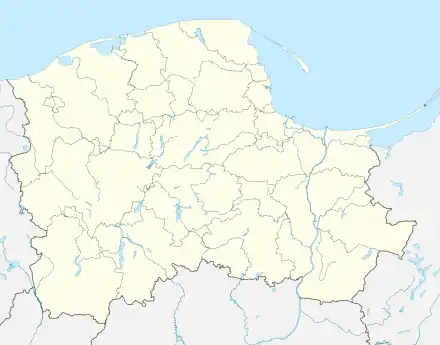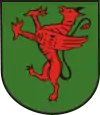Rokitki, Tczew County
Rokitki [rɔˈkitki] (German: Rokittken, 1942–45 Rokitten) is a village in the administrative district of Gmina Tczew, within Tczew County, Pomeranian Voivodeship, in northern Poland.[1] It lies approximately 3 kilometres (2 mi) south-east of Tczew and 33 km (21 mi) south of the regional capital Gdańsk. It is located within the ethnocultural region of Kociewie in the historic region of Pomerania. The village was previously known as Reisicht.
Rokitki | |
|---|---|
Village | |
 Rokitki  Rokitki | |
| Coordinates: 54°4′43″N 18°44′15″E | |
| Country | |
| Voivodeship | Pomeranian |
| County | Tczew |
| Gmina | Gmina Tczew |
| Population | 522 |
| Time zone | UTC+1 (CET) |
| • Summer (DST) | UTC+2 (CEST) |
The village has a population of 522.
History
The name of the village comes from a willow species, known in Polish as wierzba rokita.
Rokitki was a royal village of the Polish Crown, administratively located in the Tczew County in the Pomeranian Voivodeship.[2] The Battle of Tczew during the Polish–Swedish War (1626–1629) was fought nearby in August 1627.
During the German occupation of Poland (World War II), in 1939, local Polish activist Paweł Miller was murdered by the Germans in the Szpęgawski Forest along with several Poles from other villages (see Intelligenzaktion),[3] and in 1940 several Polish families were expelled and deported to forced labour, while their farms were handed over to Germans as part of the Lebensraum policy.[4]
References
- "Central Statistical Office (GUS) - TERYT (National Register of Territorial Land Apportionment Journal)" (in Polish). 2008-06-01.
- Marian Biskup, Andrzej Tomczak, Mapy województwa pomorskiego w drugiej połowie XVI w., Toruń, 1955, p. 113 (in Polish)
- Maria Wardzyńska, Był rok 1939. Operacja niemieckiej policji bezpieczeństwa w Polsce. Intelligenzaktion, IPN, Warszawa, 2009, p. 149-150 (in Polish)
- Maria Wardzyńska, Wysiedlenia ludności polskiej z okupowanych ziem polskich włączonych do III Rzeszy w latach 1939-1945, IPN, Warszawa, 2017, p. 71-72 (in Polish)
